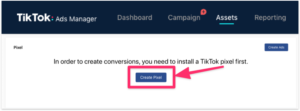
Last Updated / Reviewed: Aug 16th, 2021
Execution Time: ~10-20 minutes
Goal: To add the TikTok tracking pixel to your site.
Ideal Outcome: The TikTok pixel is properly installed without any technical issues.
Prerequisites or requirements: You’ll need access to an active TikTok for Business account. Also, you’ll need access to Google Tag Manager (GTM) that was set up on your website.
If you don’t have a TikTok For Business account, sign up here.
If you haven’t set up Google Tag Manager, refer to the following SOPs:
– Set up Google Tag Manager on WordPress
– Set up Google Tag Manager on Shopify
– Set up Google Tag Manager on Squarespace
Why this is important: The TikTok Pixel allows you to track visitors who come from your TikTok ad campaigns. You can also track website visitor actions, like ‘Pageviews’ or ‘Purchases’ and create audience segments to retarget them.
Where this is done: In Google Tag Manager and TikTok Ads Manager.
When this is done: Before you run any TikTok advertising campaign on your website. You only need to do this once unless you’re running TikTok ads on multiple websites.
Who does this: The person responsible for website management, analytics, or paid advertising.
________________________________________
● Environment Setup
Before you start:
1. Open a new browser window with your TikTok and Google Tag Manager account signed in.
2. Download the TikTok Pixel helper
● Installing TikTok Pixel via Google Tag Manager
1. Sign in to TikTok for Business
2. Once signed in. Head to Events manager.

3. Click to Website Pixel.

4. Select the Create Pixel button. A pop up will appear:

5. Creating your Pixel:
a. Give your Pixel a name
b. Select “Install Pixel code by 3rd party tool”.
c. Click “Next”

6. Select Google Tag Manager. Then click next.

7. Click Connect to a Google Account.

8. You’ll be asked to login to your Google account. Make sure all the Google Tag Manager permissions are checked. This allows Google Tag Manager and the TikTok Pixel to communicate with each other.
a. Note: Double-check that you’re logging into the correct Google account (the one that has access to your Google Tag Manager container).

9. Your Google Tag Manager details will be automatically populated. Make sure you are selecting the correct Account and Container, if so click “Next”.

10. You have now successfully installed the TikTok Pixel via Google Tag Manager. Clicking Complete will redirect you to the Pixel dashboard.

● Create a Page View event
Important: Once you have installed the TikTok Pixel, you can now create events to track various activities a visitor performs on your website. For example: viewing a page, clicking a button, buying a product, etc.
The following walks you through the steps of creating an event to track someone viewing a specific page.
1. In the Pixel Dashboard, click Complete Pixel Setup.

2. Select Standard Mode.

3. In the next screen, click “Complete & Set Rules”

4. Select Custom Events.

5. Since this is an event to track page views, select the appropriate pixel settings. Click next.

6. Since you’re tracking page views, select “Destination URL”, this will be where you will be firing your event.

7. Add a page browsing rule.

8. Since you’re tracking all page views, you will add the rule: “Page URL” “Contains” “[Insert your homepage URL]”, then hit “Save & Complete”. You’ll be redirected back to the dashboard with the Page Views event successfully created.

9. You have now set up the “Page Views” event.

● Verifying the TikTok and Event Pixels are installed correctly
Important: It takes about 15-30 minutes for both Google Tag Manager and TikTok’s event pixel to start sending signals.
1. Head over to your website after 30 mins and refresh a couple of times for the event pixel to kick in.
2. Click the TikTok Pixel helper In your Google Chrome toolbar, you should see both the TikTok and Event pixels are now tracked.

3. Now head back to TikTok’s Event Manager and you’ll see the page view metrics are now tracked.

4. You’ve done it! Now that you’ve started tracking page views across your website, you can set up tracking for other metrics such as add to cart and purchase events.